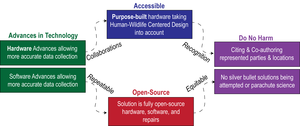Conservation Tools: The Next Generation of Engineering–Biology Collaborations
2023
Article
hi
The recent increase in public and academic interest in preserving biodiversity has led to the growth of the field of conservation technology. This field involves designing and constructing tools that utilize technology to aid in wildlife conservation. In this review, we present five case studies and infer a framework for designing conservation tools based on human-wildlife interaction. Successful conservation tools range in complexity from cat collars to machine learning and game theory methodologies and do not require technological expertise to contribute to conservation tool creation. We aim to introduce researchers to conservation technology and provide references for guiding the next generation of conservation technologists. Conservation technology has the potential to benefit biodiversity and have broader impacts on fields such as sustainability and environmental protection. By using innovative technologies to address conservation challenges, we can find more effective and efficient solutions to protect and preserve our planet's resources.
| Author(s): | Andrew Schulz and Cassie Shriver and Suzanne Stathatos and Benjamin Seleb and Emily Weigel and Young-Hui Chang and M. Saad Bhamla and David Hu and Joseph R. Mendelson III |
| Journal: | Royal Society Interface |
| Year: | 2023 |
| Department(s): | Haptic Intelligence |
| Bibtex Type: | Article (article) |
| Paper Type: | Journal |
| DOI: | 10.1098/rsif.2023.0232 |
| Note: | Andrew Schulz, Cassie Shriver, Suzanne Stathatos, and Benjamin Seleb are co-first authors. |
| State: | Published |
|
BibTex @article{Schulz23-ConTech-Interface,
title = {Conservation Tools: The Next Generation of Engineering--Biology Collaborations},
author = {Schulz, Andrew and Shriver, Cassie and Stathatos, Suzanne and Seleb, Benjamin and Weigel, Emily and Chang, Young-Hui and Bhamla, M. Saad and Hu, David and III, Joseph R. Mendelson},
journal = {Royal Society Interface},
year = {2023},
note = {Andrew Schulz, Cassie Shriver, Suzanne Stathatos, and Benjamin Seleb are co-first authors.},
doi = {10.1098/rsif.2023.0232}
}
|
|


